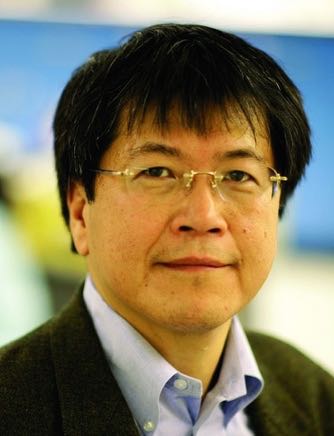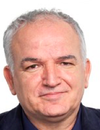Co-Located Conference AgendasPoint-of-Care Diagnostics & Global Health 2018 | Single Cell Analysis Summit 2018 |  Other Track Agendas Other Track AgendasLab-on-a-Chip and Microfluidics: Companies, Technologies and Commercialization "Track B" | Lab-on-a-Chip and Microfluidics: Emerging Themes, Technologies and Applications "Track A" |

Monday, 1 October 201813:00 | Conference Registration and Materials Pick-Up | |
Session Title: Congress Plenary Session |
| | |
Plenary Session Chairperson: Leanna Levine, Ph.D., Co-Founder & CEO, ALine, Inc. |
| | 14:00 |  | Keynote Presentation Wearable Microfluidic and Microtubular Sensors For Biomedical Applications
Chwee Teck Lim, NUS Society Chair Professor, Department of Biomedical Engineering, Institute for Health Innovation & Technology (iHealthtech), Mechanobiology Institute, National University of Singapore, Singapore
The future of healthcare wearables lies in continual sensing in an
unobtrusive manner. Tactile sensing is especially important to capture
mechanotransduced signals arising from the body, or as a result of
interactions with the external environment. However, conventional
sensors are rigid, stiff and obstrusive. Therefore, one of the key
objectives is to confer flexibility and stretchability to our sensing
elements, while maintaining its sensitivity and robustness. Here, we
develop a novel liquid-based microfluidic and microtubular sensors that
possess high flexibility, durability, and sensitivity. The sensors
comprise a soft elastomer-based microfluidic template encapsulating a
conductive liquid which serves as the active sensing element of the
device. This sensor is capable of distinguishing and quantifying the
various user-applied mechanical forces it is subjected to. We
demonstrated biomedical applications of our sensors in rehabilitation
monitoring, artificial sensing and disease tracking such as that for
diabetic patients. Overall, our work highlights the potential of the
liquid-based microfluidic sensing platform in a wide range of biomedical
applications and further facilitates the exploration and realization of
functional liquid-state device technology. |
| 14:30 |  | Keynote Presentation Wearable Microfluidics For Real-Time Personal Monitoring
Martyn Boutelle, Professor of Biomedical Sensors Engineering, Imperial College London, United Kingdom
Tissue functions at a cellular level by exchange of molecules either between cells and blood or between the cells themselves. This produces patterns of molecular change that are diagnostic of cellular processes whose origin can be physiological (exhaustion, pregnancy) or pathological (ischemia, renal failure, cancer). Our technologies have now developed to a point where we can aspire to do more than this, to measure from patients in real-time. The has the great benefit that it is them possible to understand the evolution of disease, the effectiveness of treatments, and ultimately to guide treatment. In this presentation I will describe the development of microfluidic devices connected to wireless electronics for transplant organ, patient and athlete monitoring. Tissue sampling is via an integrated microfluidic device, a microdialysis probe. Molecular biomarkers are measured using microscale integrated amperometric biosensors and solid-contact ion-selective electrodes (ISE) for tissue ionic balance. For detailed patterns of ionic responses we have developed high density Field Effect Transistor (FET) array which function as ISEs within the flow stream. We have also edevelodp multiphase flow microfluidic systems for highest time resolution.The presentation with describe the design and optimization challenges and include clinical examples from our recent work. |
| 15:00 |  | Keynote Presentation Advancing the Performance of Low Cost Diagnostics For Global Health
Bernhard Weigl, Director, Center for In-Vitro Diagnostics, Intellectual Ventures/Global Good-Bill Gates Venture Fund, United States of America
We will present lab and field results with recently developed lateral flow and similar assays for global health. Our group’s mission is to develop assays for use in global health applications that are as sensitive as the best conventional diagnostic assays (in some cases even better) while retaining cost, simplicity, and usability advantages. For our lateral flow assay work we have developed a 3D modeling platform for paper-based assays and are using it to determine the theoretical limit of a particular assay variant, as well as a rapid array-based empirical optimization system for lateral flow assays. Together, these approaches allow the development of more sensitive assays with shortened development time. We will describe the assay optimization methods we employ, as well the use of these methods in the development of several assays under development, including ones for malaria, and TB. |
| 15:30 |  | Keynote Presentation Absolute Quantification of Molecular Biomarkers
Hsueh-Chia Chang, Bayer Professor of Chemical and Biomolecular Engineering, University of Notre Dame, Interim Chief Technology Officer, Aopia Biosciences, United States of America
We report several micro/nanofluidic technologies we invented that can
overcome the sensitivity obstacles for liquid biopsy: (1) A chip
electrophoresis module for high-yield exosome extraction without
centrifugation; (2) A Surface Acoustic Wave exosome lysing module that
replaces chemical lysing and eliminates the need for low-yield
solid/liquid miRNA extraction; (3) A solid-state polymer nanopore fM
assay that can delay translocation of short 20-nt miRNAs and
differentiate the duplexes that have hybridized with inserted oligos and
the wild-type miRNAs; (4) A Carbon-Nanotube Protein Sensor with fM
sensitivity, three orders of magnitude below KD. Integrated into a
biochip, these technologies allow us to quantify protein biomarkers for
breast cancer and miRNAs for pancreatic cancer, from patient blood
samples, at sensitivities far better than CTC and current molecular
biomarker assays, with dramatically improved AUC and p values. We have
eliminated low-yield extraction steps and employed irreversible kinetics
to achieve such high performances and have allowed absolute
quantification without the need for house-keeping reference molecules. |
| 16:00 | Coffee Break and Networking | 16:30 |  | Keynote Presentation Nanosensors for Single-molecule Sequencing
Steve Soper, Foundation Distinguished Professor, Director, Center of BioModular Multi-Scale System for Precision Medicine, The University of Kansas, United States of America
We are generating a single-molecule DNA sequencing platform that can
acquire sequencing information with high accuracy. The technology
employs arrays of nanosensors that read the identity of individual
mononucleotides from their characteristic electrophoretic mobility and
current transient amplitudes through a 2-dimensional (2D) nanochannel
(~20 nm in width and depth; <10 µm in length) fabricated in a
thermoplastic via nano-imprinting (NIL). The mononucleotides are
generated from an intact DNA fragment using a highly processive
exonuclease, which is covalently anchored to a plastic solid support
contained within a bioreactor that sequentially feeds mononucleotides
into the 2D nanochannel. We will discuss the operation of this
nanosensor in this presentation as well as its production. |
| 17:00 |  | Keynote Presentation Quantum Diagnostics: From Single Cells to Single Molecules
Dino Di Carlo, Armond and Elena Hairapetian Chair in Engineering and Medicine, Professor and Vice Chair of Bioengineering, University of California-Los Angeles, United States of America
The ultimate limits of sensitivity in measuring biological systems
occurs at the level of single-cells and single-molecules. I will discuss
our approaches leveraging microfluidic and microfabrication
technologies to interface at the scale of these single entities. In
particular, we make use of the ability to compartmentalize fluid volumes
to a sub-nanoliter scale and manipulate cells using unique microscale
physics. I will discuss progress in using these quantized or digital
measurements towards single-molecule infectious disease diagnostics,
characterizing the immune evasion state of circulating tumor cells, and
screening for drugs that modulate the contractile forces that single
muscle cells apply. |
| 17:30 |  | Keynote Presentation Integrated Isolation, Detection and Analysis of cf-DNA and Exosome Biomarkers from Cancer Patient Blood Samples - The Road to POC Liquid Biopsy Diagnostics
Michael Heller, Professor, Dept Bioengineering, University of California-San Diego, United States of America
New AC electrokinetic (ACE) microarray/chip device allows 15-20-minute isolation of cancer related cf-DNA, exosomal RNA and protein biomarkers directly from 20-50ul of patient blood, plasma or serum. Cf-DNA levels can be immediately determined directly on the chip (in-situ) using DNA specific dyes and then immunofluorescent analysis can be carried out to identify exosomal protein biomarkers. Presently, cf-DNA and exosomal RNA are then eluted from the ACE chip, and PCR and sequencing analysis carried out to identify the cancer-related point mutations. New procedures are now being developed to carry out on-chip PCR for DNA/RNA analysis. On-chip integration of proteomic and genomic analysis is a major step forward in the quest for seamless sample to answer POC liquid biopsy diagnostics. |
| 18:00 |  | Keynote Presentation Cost-effective and Globally Deployable Mobile Diagnostics Using Paper-Based Nanobiosensors
Arben Merkoçi, ICREA Professor and Director of the Nanobioelectronics & Biosensors Group, Institut Català de Nanociencia i Nanotecnologia (ICN2), Barcelona Institute of Science and Technology (BIST), Spain
Point of care devices are progressing rapidly and the demand for cost
efficient globally deployable mobile diagnostics platforms is the key
factor for their success. Physical, chemical and mechanical properties
of cellulose in both micro and nanofiber-based networks combined with
their abundance in nature or easy to prepare and control procedures are
making these materials of great interest while looking for
cost-efficient and green alternatives for device production
technologies. Both paper and nanopaper-based biosensors are emerging as a
new class of devices with the objective to fulfil the “World Health
Organization” requisites to be ASSURED: affordable, sensitive, specific,
user-friendly, rapid and robust, equipment free and deliverable to
end-users. How to design simple paper-based biosensor architectures? How
to tune their analytical performance upon demand? How one can
‘marriage’ nanomaterials such as metallic nanoparticles, quantum dots
and even graphene with paper and what is the benefit? How we can make
these devices more robust, sensitive and with multiplexing capabilities?
Can we bring these low cost and efficient devices to places with low
resources, extreme conditions or even at our homes? Which are the
perspectives to link these simple platforms and detection technologies
with mobile phone communication? I will try to give responses to these
questions through various interesting applications related to protein,
DNA and even contaminants detection all of extreme importance for
diagnostics, environment control, safety and security. |
| 18:30 | Networking Reception in the Exhibit Hall with Beer, Wine and Dinner. Meet the Exhibitors and Network with Your Colleagues | 20:00 | Close of Day 1 of the Conference. |
Tuesday, 2 October 201809:00 | Tuesday, 2 October 2018 -- Full Morning in Concurrent Lab-on-a-Chip and Microfluidics "Track A" | |
Session Title: Presentations from Companies Developing Technologies and Tools in Microfluidics |
| | 14:00 |  MEMS & Microfluidic Commercialization by IMT Microtechnologies MEMS & Microfluidic Commercialization by IMT Microtechnologies
Alexios Tzannis, Business Development Manager Life Sciences, IMT Microtechnologies
Microfluidics, or lab-on-a-chip technology, is a powerful tool positioned in the intersection of biotechnology, automation, and functional integration. Microfluidic devices can shuttle picoliter, and smaller, volumes of fluids into functional regions, enabling powerful in vitro diagnostics (IVD) harnessing everything from digital biology, to next generation sequencing, organs-on-a-chip, high-throughput cell-based assays, or high-density multifunctional chips for drug discovery and bioanalysis, while shrinking sample and reagent volumes. The overall complexity can be addressed by transferring MEMS production schemes and equipment into the field of microfluidics. Thanks to advances in laser machining, photolithography, etching automation, wafer bonding, functionalization, room temperature UV-adhesive bonding and other process improvements, glass and glass-hybrid materials are often both the best-performing and most cost-effective consumable material for Life Science and Diagnostics devices. Here IMT offers leading edge technologies with automated and standardized processes. In this paper we discuss the challenges and solutions of implementing WLP processes for products.
| 14:30 |  Precise Contactless Spotting for Lab-on-Chip Applications Precise Contactless Spotting for Lab-on-Chip Applications
Wilhelm Meyer, Managing Director, Microdrop Technologies GmbH
Lab-on-chip devices are used for a wide variety of health care applications, especially in the area of point-of-care diagnostics. These small microfluidic devices equipped with microchannels, chambers and other features carry out diagnostic tests by enabling reactions between patient samples and reagents. The devices deliver test results with very small sample volumes and in a short period of time. For production of lab-on-chip devices a precise and fast material deposition method is needed. Typically, the devices are produced at high numbers under high throughput conditions. The substrates may be made of different materials e.g. polystyrene or silicone, but in common is that these substrates typically have a structured surface which may consist of channels, mixing chambers or even wells which are used for precise detection. Also, different coating materials may be used as pretreatment for better adhesion of reagents or confinement of fluids. Deposition or Spotting of reagents onto the chip is a demanding task and requires the filling of small cavities and microchannels with a high accuracy. This can efficiently be done with a microspotting platform based on in inkjet technology. The flexibility of this technology allows for custom-made solutions adapted to the specific customer needs. Especially how high accuracy concerning volume of spotted reagents and also precision of placement is achieved under high throughput production conditions is demonstrated by examples.
| 15:00 | Developing Novel Bioinstrumentation for Clinically-Relevant Diagnostics
Barbara Smith, Assistant Professor, School of Biological and Health Systems Engineering, Arizona State University, United States of America
Translational diagnostics has gained considerable interest over the past
decades due, in great part, to the wide range of potential applications
through clinical, personalized, and research approaches. Failure of
current technologies to provide real-time feedback and clinical
screening does not stem from either a lack of medical interest or
importance; rather, it is sourced in three major difficulties: i)
miniaturization of technology for use in vivo, and ii) ease of use, and
iii) cost of the exam. This presentation will introduce our recent work
integrating photoacoustics and ultrasound technologies for the
development of new tools for non-invasive diagnostics. The overarching
goal is to translate technologies developed in the lab for improved
patient outcomes. | 15:30 | Coffee Break and Networking in the Exhibit Hall | 16:00 |  Integrating Optical Detection Technology into Microfluidic Consumables Integrating Optical Detection Technology into Microfluidic Consumables
John Town, SVP Technology, TECHNICOLOR PRECISION BIODEVICES
Technicolor brings over 100 years of technical innovation across a broad range of disciplines to the microfluidic consumable manufacturing space with both a global manufacturing infrastructure and world class Research Laboratories. This presentation provides a review of Technicolor’s advanced microfluidic consumable fabrication techniques and features a case study of the development of an operating microfluidic consumable demonstrating the integration of micro-optics into a microfluidic consumable to aid, enhance and simplify detection techniques.
| 16:30 |  HP Inkjet Microfluidics for Life Sciences Research HP Inkjet Microfluidics for Life Sciences Research
Ken Ward, Applications Director, HP, Inc.
Digital dispensing has now been available to improve dose-response research for several years. HP would now like to make this accessible to a wider range of researchers. Furthermore, bringing dispense capability beyond well plates to spatially resolved patterning also provides greater utility. These examples and more will be illustrated with customer data in this presentation.
| |
Panel Discussion: Perspectives on Developing a POC Diagnostic For Global Health | | Session Chair: Amy Adelberger, Founder and CEO, Global Impact Advisors, United States of America |
| | 17:00 | Perspectives on Developing a POC Diagnostic For Global Health
Amy Adelberger, Founder and CEO, Global Impact Advisors, United States of America
The aim of the panel is to discuss the challenges and opportunities in developing POC Dx for global health applications. This will be a panel discussion. Our panelists will share their perspectives on what it takes to succeed or fail developing POC diagnostics for global health applications as well as insights about funding global health POC diagnostics. | 17:15 | Do We Need a GAVI For Diagnostics in the Developing World?
Jim Gallarda, Senior Program Officer, Bill & Melinda Gates Foundation, United States of America
Silos are the chief impediment to progress in global health. Technology innovation is needed, but not sufficient to achieve impact. Adopting an “end-to-end” strategy requires deep knowledge and connectiveness among supply, demand, and facilitating stakeholders. GAVI, The Vaccine Alliance, provides a model that might work for diagnostics. | 17:30 | Point-of-Care Pathogen Diagnostics for the Developed and Developing Worlds
Paul Yager, Professor, Department of Bioengineering, University of Washington and CSO, UbiDX, Inc., United States of America
| 17:45 | Perspectives on Developing a POC Diagnostic for Global Health
Charles Daitch, CEO, Akonni Biosystems Inc., United States of America
The aim of the panel is to discuss the challenges and opportunities in developing POC Dx for global health applications. This will be a panel discussion. Our panelists will share their perspectives on what it takes to succeed or fail developing POC diagnostics for global health applications as well as insights about funding global health POC diagnostics. | 18:00 | Networking Reception in the Exhibit Hall with Beer and Wine. Meet the Exhibitors and Network with Your Colleagues | 19:30 | HP Free Workshop Entitled "Deep Dive -- HP Inkjet Chips for New Research Applications" | 21:00 | Close of Day 2 of the Conference. |
Wednesday, 3 October 201807:30 | Morning Coffee and Breakfast Pastries in the Exhibit Hall | 08:00 |  Precigenome Pressure and Flow Controller and its Applications Precigenome Pressure and Flow Controller and its Applications
Chen Li, Vice President of R&D, Precigenome LLC
We will present a multiple channel (4 or 8 channels) pressure and flow controller based on our proprietary technology. This portable controller can provide pulseless accurate pressure and vacuum (<0.1% of set value) in a fast response time (<2s) without outside pressure and vacuum source. The controller can also connect to flow sensors (optional feature) and use feedback loop to monitor flow rates and control pressures to obtain constant flow rates. The controller has many applications on microfluidic field. One of applications is to generate micro droplets in microfluidic chips. We developed a droplet generator based on our pressure control technology. In this presentation, we will also present several applications co-developed with our customers using our droplet generators, such as sample preparation for next generation sequencing and rare cancer cell detection.
| 08:30 |  Microfluidic Volume Manufacturing on Leading-Edge Imprint and Bonding Equipment Microfluidic Volume Manufacturing on Leading-Edge Imprint and Bonding Equipment
Bernd Dielacher, Business Development Manager, EV Group (EVG)
EV Group is a world leader in wafer-processing solutions for semiconductor, MEMS and nanotechnology applications as well as holds a dominant position in nanoimprint lithography for the photonic and biotechnology market.
This talk will focus on Nanoimprint Lithography (NIL) as a powerful high-volume manufacturing technique that is able to fabricate the most complex and smallest structures and thus is ideally suited for the production of next-generation microfluidic devices. Different NIL technologies such as hot-embossing and UV-NIL with respect to microfluidic device fabrication will be reviewed. The presentation will also discuss microfluidic bonding solutions that are well-aligned with NIL structuring technologies and allow for full high-volume process integration.
| 09:00 |  Low-Concentration Samples: The Next Diagnostic Frontier Low-Concentration Samples: The Next Diagnostic Frontier
Richard Chasen Spero, CEO, Redbud Labs
New platforms for molecular analysis have ushered in a golden era of biomarker discovery and diagnostic development. Looking ahead, the greatest diagnostic challenges have a common thread: the analyte is present in extremely low concentration. We discuss novel methods for improving limit of detection in analyte-limited samples.
| 09:30 |  Mix and Match: Manufacturing Multimaterial for Lab-on-a-Chip Devices Mix and Match: Manufacturing Multimaterial for Lab-on-a-Chip Devices
Holger Becker, Chief Scientific Officer, Microfluidic ChipShop GmbH
Highly integrated microfluidic devices usually consist out of components made out of different materials such as thermoplastic polymers for the cartridge body, membranes and filters, blister pouches for liquid reagents and/or silicon dies for sensors. The presentation will discuss challenges and solutions for developing and manufacturing of such multimaterial cartridges.
| 10:00 |  Modeling and Simulation of Microfluidic Devices Modeling and Simulation of Microfluidic Devices
Matthew Hancock, Managing Engineer, Veryst Engineering, LLC
Modeling and simulation are key components of the engineering development process, providing a rational, systematic method to engineer and optimize products and dramatically accelerate the development cycle over a pure intuition-driven, empirical testing approach. Modeling and simulation help to identify key parameters related to product performance (“what to try”) as well as insignificant parameters or conditions related to poor outcomes (“what not to try”). For microfluidic devices, modeling and simulation can inform the design and integration of common components such as mixers, micropumps, manifolds, and channel networks. Modeling and simulation may also be used to estimate a range of processes occurring within the fluid bulk and near cells, including shear stresses, transport of nutrients and waste, chemical reactions, heat transfer, and surface tension & wetting effects. I will discuss how an array of modeling tools such as scaling arguments, analytical formulas, and finite element simulations may be leveraged to address these microfluidic device development issues. I will also work through a few examples in detail.
| 10:30 | Coffee Break and Networking in the Exhibit Hall | 11:00 |  Engineered Microfluidic Components for System Integration: Case Studies and Lessons learned Engineered Microfluidic Components for System Integration: Case Studies and Lessons learned
Leanna Levine, Founder & CEO, ALine, Inc.
Moving quickly from a design to a working benchtop system allows product developers to optimize the analytical triad in microfluidic product development: Cartridge + Instrument + Reagent workflow. In this presentation we provide an overview of our strategies for multi-step assay implementation in a microfluidic platform within 12 weeks, using examples from case studies and highlighting the key lessons learned during the development program.
| 11:30 |  Minimizing Experimental Variability in Microfluidics: Attaining Robustness, Reproducibility and Reliability Minimizing Experimental Variability in Microfluidics: Attaining Robustness, Reproducibility and Reliability
Thomas Corso, Chief Technical Officer, CorSolutions
| 12:00 |  Non-Contact, Low Volume Dispensing Solutions for the Biosensor Industry Non-Contact, Low Volume Dispensing Solutions for the Biosensor Industry
Chris Fronczek, Director of Applications, BIODOT, Inc.
Low Volume Dispensing Solutions for the Biosensor Industry
| 12:30 | Networking Lunch in the Exhibit Hall -- Meet the Exhibitors and View Posters | 13:00 |  Luncheon Technology Spotlight: Scalability of Microfluidic Cartridge Design Luncheon Technology Spotlight: Scalability of Microfluidic Cartridge Design
Mark Kinder, President, Plastic Design Corporation
When starting on a new microfluidic design, there are several stages of prototyping and design validation. In early stages, with tight budgets, non-scalable manufacturing techniques are often used to manage development budgets. Too often, when the design proves successful, it must be scraped or radically changed to allow a cost effective product moving forward. Or worse, a poor design from a DFM perspective is forced into production with high scrap rates. This presentation will look at:
1. When to incorporate DFM (Design for Manufacturability)
2. What is Design for Manufactuability
3. What resources are available to help, software, suppliers
4. How to identify eventual production requirements
5. How to create a strategy to match your budget
| 13:30 |  Molecular Surface Engineering of Bio-Compatible Coatings Molecular Surface Engineering of Bio-Compatible Coatings
Jeff Chinn, Chief Technical Officer, Integrated Surface Technologies
Surface engineering techniques through to use of specialized molecular chemistries can be used to develop or mitigate a wide range of functional properties, including physical, chemical, fluid flow, electrical, and corrosion-resistant properties. Almost all types of materials including metals, semiconductors, ceramics, polymers, and composites can be coated with molecular films to alter their surface states. Common surface engineered properties of interest often include: control of surface energies (hydrophobicity, hydrophilicity, anti-fouling), chemical grafting (functional groups –NH2, -OH, -COOH, -SH2, etc.), molecular level cleaning, surface activation, adhesion promotions (chemical activation for bonding, immobilizing DNA) and preservation (corrosion inhibitors, moisture barriers). These nano-scaled films can be engineered into many unique bio-compatible coatings. In this talk, we will review the basics of molecular coatings that are commonly used and a technique to applied and to control of surface properties for applications like micro-fluidics, genomics, PCR and others.
| 14:00 |  Point of Care: Coping with Complexity Point of Care: Coping with Complexity
Jim Sirkis, Chief Technology Officer, IDEX Health & Science
Complexity, manufacturability and cost converge in applications that require sample-to-answer solutions. Dr. Jim Sirkis, CTO of IDEX Health & Science, will present on the critical factors and focus affecting complex microfluidic consumables. Dr. Sirkis oversees global technology development for IDEX Health & Science, including the recent integration of thinXXS Microtechnology. Combined together, IH&S now offers the largest and most comprehensive microfluidics portfolio optimizing the Optofluidic pathway. Dr. Sirkis will review the interdependencies between low cost precision molding, reagent management, fluid handling, assay detection and the importance of informed, systems-based decision making when designing a successful consumable platform.
| 14:30 |  Influences on Vapor Phase Amino Silane Coatings Influences on Vapor Phase Amino Silane Coatings
Ken Sautter, Director of Technology Development, Yield Engineering Systems, Inc.
Vapor phase coating is increasingly important to creating repeatable, thin, uniform interface layers between inorganic substrates and bio materials. Of the hundreds of silane materials available, amino silanes are the most common materials coated for biologic applications. This paper will explore coating conditions which affect density and stability of the amino silane coating including temperature, pressure and humidity.
| 15:00 |  A Unique Collaboration For Rapid Prototyping Injection Molded Microfluidic Devices A Unique Collaboration For Rapid Prototyping Injection Molded Microfluidic Devices
Markus Ebster, Vice President Sales & Marketing, z-microsystems®
z-microsystems is located in Austria and Canada specializing in micro-injection moldmaking and injection molding of microfluidic devices with over 15 years experience in the industry. Their unique core competence is how to help design a microfluidic device that is injection moldable, prototype it, manufacture the micro-injection molds in-house, transition into a pre-production/pilot phase before taking the process into full mass production under stringent clean room conditions. Following several years of study and establishing a strong relationship with the University of Toronto, they identified the need to replace PDMS chip manufacture with a faster, better quality, more repeatable and cost effective method, to rapid prototype new microfluidic device designs. Collaborating with the university, z-microsystems Canadian office was eligible for federal funding and started a unique development project in November 2015. The development combines the universities know-how in their Centre for Microfluidics Systems with z-microsystems injection molding experience, to deliver a viable and value-added alternative to rapid prototype new microfluidic devices.
| 15:30 | Afternoon Coffee Break | 16:00 |  | Keynote Presentation Microfluidics For Biohybrid Devices
Shoji Takeuchi, Professor, Center For International Research on Integrative Biomedical Systems (CIBiS), Institute of Industrial Science, The University of Tokyo, Japan
In this presentation, I will talk about several approaches to develop MEMS/Microfluidic devices combined with living materials for various biomedical sensing and healthcare applications. Living materials show superior functions to the artificial ones such in terms of the ability to recognize/produce biomolecules. For example, membrane proteins achieve highly-sensitive and selective detection of several chemicals at the molecular level; they can even distinguish between different chemical moieties found in various odorants. When a certain ion channel activating a single ligand molecule opens for 1 s under a 100 mV-membrane potential, the number of monovalent ions that are transferred through the ion channel reaches the 106-107 level and generates a few pico-amperes. This reaction means that chemical signals are converted to amplified current signals in living systems; the system can be regarded as a transistor with an excellent amplifier. Here, one of my talk will include our approaches toward biohybrid sensors: a microdevice having membrane proteins (receptors) reconstituted into cells or planar lipid bilayers. We believe that the devices are useful for a highly-selective and rapid detection of various chemicals including drugs, odorants and tastants. This approach is likely to lead to a wide variety of applications including environmental monitoring, food control, and highly-sensitive diagnostic tools. |
| 16:30 | Single Cell Array Printing Technique and Its Application for Cancer Migration
Shengli Mi, Associate Professor, Biomanufacturing Engineering Laboratory, Tsinghua University-Shenzhen, China
Single-cell arrays are powerful tools for many biological processes such
as cellular behavioral analysis, cancer development, cell-cell
communications, and drug screening and metabolism. Based on the
Alternating Viscous-Inertial Force Jetting, we present a novel
single-cell printing technique for the construction of single-cell
arrays on microfluidic chips. First of all, this work accomplished the
construction of single-cell printing platform and parameters
optimization. Then a pattern microfluidic device matched with
single-cell array was proposed to verify the pattern control capability
of the single-cell printing platform and the effectiveness of the
printing process. Finally our work come up with another microfluidic
chip which had hundreds of micro-reactors and studied the migration
ability and high-throughput anti-cancer drug responses of cancer cell as
an important application. | 17:00 | Hydrodynamic Flow Confinements: From Surface Biopatterning to Tissue Section Profiling
Iago Pereiro, Researcher, IBM Research – Zurich, Switzerland
In contrast to standard microfluidics, which are typically closed, we are developing a scanning, non-contact microfluidic technology that can shape liquids in the "open space" over surfaces. This technology utilizes a microfluidic probe (MFP) having microfabricated structures for localizing a liquid of interest on a surface using hydrodynamic flow confinement. MFP permits patterning surfaces with proteins and other biomolecules in an additive and subtractive manner, forming complex gradients on surfaces, and interacting with cells on surfaces. Flow confinement and efficient use of chemicals can be further optimized using a concept called "hierarchical" hydrodynamic flow confinement. I will show how the interplay between diffusion, advection and surface chemistry can overcome limitations of existing biopatterning technologies. I will also propose concepts pertaining to tissue microprocessing encompassing local phenotyping for interrogating tumor heterogeneity and spatially resolved molecular profiling which may contribute to the multi-modal analysis of critical biopsy samples in the context of next-generation pathology. | 17:15 | High-throughput Production and Shrinkage of Microbubbles for use as Ultrasound Contrast Agents
Jiang Xu, Postdoctoral Research Fellow, Ryerson University, Canada
Highly monodispersed microbubbles at high through-put are generated and subsequently further reduced in size using a vacuum shrinkage mechanism coupled with microfluidics. | 17:30 | Development of a Lab-on-a-Chip For Proteomics
Menel Ben Frej, Engineer, Chimie ParisTech - Université Paris Descartes, France
A microfluidic device was designed and developed for the isoelectric focusing, digestion and detection of proteins. A hybrid lab-on-a-chip made of glass-NOA-glass coupled to Mass spectrometry was set-up for this purpose. | 17:45 | Development of a Lab-on-a-Chip For the Analysis and the Recycling of Strategic Metals
Jérémie Gouyon, Researcher, Chimie ParisTech - Université Paris Descartes, France
A microfluidic device was designed and developed for the analysis and recycling of strategic metals. A hybrid lab-on-a-chip made of glass-NOA-glass coupled to an amperometric detector was set-up for the separation, detection and recovery of palladium and platinum. | 18:00 | Development of an Aptamer-based Microfluidic System For the Multi-Detection of Cancer Biomarkers
Samantha Bourg, Researcher, Chimie ParisTech - Université Paris Descartes, France
This study aims at developing a LOAC to achieve automation and high-thoughput screening for cancer prevention and early diagnosis. Focus will be given to the development of an aptamer-based molecular recognition strategy for the dynamic capture and concentration of biomarkers. | 18:15 | Controlled Deflection of Diamagnetic Biocompatible Aqueous Droplets
Stephanie Buryk-Iggers, Researcher, Ryerson University, Canada
We present a microfluidic platform that is capable of controlled diamagnetic droplet displacement. In this method, monodisperse aqueous droplets are produced in a continuous phase of hydrophobic ferrofluid. Both phases are exposed to magnetic field. Precise deflection of the aqueous droplets is then achieved in a single step by adjusting the flow-rate of the disperse phase. | 18:30 | Close of Conference. |
|


 Add to Calendar ▼2018-10-01 00:00:002018-10-03 00:00:00Europe/LondonLab-on-a-Chip and Microfluidics: Companies, Technologies and Commercialization "Track B"SELECTBIOenquiries@selectbiosciences.com
Add to Calendar ▼2018-10-01 00:00:002018-10-03 00:00:00Europe/LondonLab-on-a-Chip and Microfluidics: Companies, Technologies and Commercialization "Track B"SELECTBIOenquiries@selectbiosciences.com